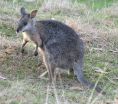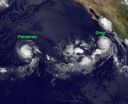(Press-News.org) Kangaroos form an important niche in the tree of life, but until now their DNA had never been sequenced. In an article newly published in BioMed Central's open access journal Genome Biology, an international consortium of researchers present the first kangaroo genome sequence – that of the tammar wallaby species – and find hidden in their data the gene that may well be responsible for the kangaroo's characteristic hop.
"The tammar wallaby sequencing project has provided us with many possibilities for understanding how marsupials are so different to us," says Prof Marilyn Renfree of The University of Melbourne. Renfree was one of the lead researchers on the project, which was conducted by an international consortium of scientists from Australia, USA, Japan, England and Germany.
Tammar wallabies have many intriguing biological characteristics. For example, the 12 month gestation includes an 11 month period of suspended animation in the womb. At birth, the young weigh only half a gram, and spend 9 months in the mother's pouch, where the newborn babies reside for protection. Researchers hope that the genome sequence will offer clues as to how tammar wallaby genes regulate these fascinating features of kangaroo life.
In addition to zeroing in on the "hop" genes, other exciting discoveries from the genome include the 1,500 smell detector genes responsible for the tammar wallaby's excellent sense of smell, and genes that make antibiotics in the mother's milk in order to protect kangaroo newborns from E. coli and other harmful bacteria. As Prof Renfree explains, lessons to be learned from the tammar wallaby genome "may well be helpful in producing future treatments for human disease."
The first kangaroo genome is a key milestone in the study of mammalian evolution. As the ancestors of kangaroos separated from other mammals at least 130 million years ago, it is hoped that the DNA sequence is in some senses a living fossil of the early mammalian species from which humans evolved. To understand this evolutionary journey better, the genome sequence is complemented by the "transcriptome" sequence, which represents a catalogue of how strongly each gene is turned "on" or "off" at different stages of the tammar life cycle and in different parts of the body. Study of the transcriptome will allow many more interesting questions to be asked about how kangaroo genes compare to their counterparts in humans.
The Genome Biology article is accompanied by a series of articles in the journals BMC Genomics, EvoDevo, BMC Immunology, BMC Molecular Biology, BMC Genetics, BMC Developmental Biology and BMC Evolutionary Biology, which collectively examine some of the most appealing biological stories arising from the genome sequence.
The tammar wallaby is only the third marsupial, and only the second Australian marsupial (after the Tasmanian devil), to have its genome sequenced. As the kangaroo is an icon of Australia, whose image appears on its coat of arms, currency and national airline symbol, the publication of its genome sequence in Genome Biology stands as a landmark day in Australian science.
INFORMATION:
Media Contact
Dr Hilary Glover
Scientific Press Officer, BioMed Central
Tel: +44 (0) 20 3192 2370
Email: hilary.glover@biomedcentral.com
Notes to Editors
1. Genome sequence of an Australian kangaroo, Macropus eugenii, provides insight into the evolution of mammalian reproduction and development
Marilyn B Renfree, Anthony T Papenfuss, Janine E Deakin, James Lindsay, Thomas Heider, Katherine Belov, Willem Rens, Paul D Waters, Elizabeth A Pharo, Geoff Shaw, Emily SW Wong, Christophe M Lefèvre, Kevin R Nicholas, Yoko Kuroki, Matthew J Wakefield, Kyall R Zenger, Chenwei Wang, Malcolm Ferguson-Smith, Frank W Nicholas, Danielle Hickford, Hongshi Yu, Kirsty R Short, Hannah V Siddle, Stephen R Frankenberg, Keng Yih Chew, Brandon R Menzies, Jessica M Stringer, Shunsuke Suzuki, Timothy A Hore, Margaret L Delbridge, Amir Mohammadi, Nanette Y Schneider, Yanqiu Hu, William O'Hara, Shafagh Al Nadaf, Chen Wu, Zhi-Ping Feng, Benjamin G Cocks, Jianghui Wang, Paul Flicek, Stephen MJ Searle, Susan Fairley, Kathryn Beal, Javier Herrero, Dawn M Carone, Yutaka Suzuki, Sumio Sagano, Atushi Toyoda, Yoshiyuki Sakaki, Shinji Kondo, Yuichiro Nishida, Shoji Tatsumoto, Ion Mandiou, Arthur Hsu, Kaighin A McColl, Benjamin Landsell, George Weinstock, Elizabeth Kuczek, Annette McGrath, Peter Wilson, Artem Men, Mehlika Hazar-Rethinam, Allison Hall, John Davies, David Wood, Sarah Williams, Yogi Sundaravadanam, Donna M Muzny, Shalini N Jhangiani, Lora R Lewis, Margaret B Morgan, Geoffrey O Okwuonu, San Juana Ruiz, Jireh Santibanez, Lynne Nazareth, Andrew Cree, Gerald Fowler, Christie L Kovar, Huyen H Dinh, Vandita Joshi, Chyn Jing, Fremiet Lara, Rebecca Thornton, Lei Chen, Jixin Deng, Yue Liu, Joshua Y Shen, Xing-Zhi Song, Janette Edson, Carmen Troon, Daniel Thomas, Amber Stephens, Laneksha Yapa, Tanya Levchenko, Richard A Gibbs, Desmond W Cooper, Terence P Speed, Asao Fujiyama, Jennifer AM Graves, Rachel J O'Neill, Andrew J Pask, Susan M Forrest and Kim C Worley
Genome Biology (in press)
Please name the journal in any story you write. If you are writing for the web, please link to the article. All articles are available free of charge, according to BioMed Central's open access policy.
Article citation and URL available on request at press@biomedcentral.com on the day of publication.
2. Genome Biology is an Open Access, peer reviewed journal that publishes research articles, new methods and software tools, in addition to reviews and opinions, from the full spectrum of biology, including molecular, cellular, organism or population biology studied from a genomic perspective, as well as sequence analysis, bioinformatics, proteomics, comparative biology and evolution.
3. BioMed Central (http://www.biomedcentral.com/) is an STM (Science, Technology and Medicine) publisher which has pioneered the open access publishing model. All peer-reviewed research articles published by BioMed Central are made immediately and freely accessible online, and are licensed to allow redistribution and reuse. BioMed Central is part of Springer Science+Business Media, a leading global publisher in the STM sector.
The first kangaroo genome sequence
2011-08-19
ELSE PRESS RELEASES FROM THIS DATE:
Researchers investigate muscle-building effect of protein beverages for athletes
2011-08-19
Physical activity requires strong, healthy muscles. Fortunately, when people exercise on a regular basis, their muscles experience a continuous cycle of muscle breakdown (during exercise) and compensatory remodeling and growth (especially with weightlifting). Athletes have long experimented with methods to augment these physiologic responses to enhance muscle growth. One such ergogenic aid that has gained recent popularity is the use of high-quality, high-protein beverages during and after exercise, with dairy-based drinks enriched with whey proteins often taking front ...
NYU Langone researchers reveal a new mechanism of genomic instability
2011-08-19
NEW YORK, August 18, 2011 – Researchers at NYU School of Medicine have discovered the cellular mechanisms that normally generate chromosomal breaks in bacteria such as E. coli. The study's findings are published in the August 18 issue of the journal Cell.
"This study provides a new explanation on how bacteria generate mutations and adapt to stressors like antibiotics. The study is quite unusual as it touches on several different fields of molecular biology at the same time: replication, transcription, translation and DNA repair," said Evgeny Nudler, PhD, The Julie Wilson ...
DOE laboratories help develop promising new cancer fighting drug, vemurafenib
2011-08-19
DOE Laboratories Help Develop Promising New Cancer Fighting Drug, Vemurafenib
Powerful X-Rays Enable Development of Successful Treatment for Melanoma and Other Life-Threatening Diseases
WASHINGTON, DC – Powerful X-ray technology developed at the U.S. Department of Energy's (DOE's) national laboratories is revealing new insights into diseases ranging from Alzheimer's to the swine flu, and, most recently, enabled the discovery of a groundbreaking new drug treatment for malignant melanoma, the deadliest form of skin cancer. The drug, Zelboraf (vemurafenib), received ...
NASA satellite data confirms Greg a hurricane, Fernanda a tropical storm
2011-08-19
Big sisters don't like being overshadowed by their younger brothers and that's what has happened in the eastern Pacific Ocean with Tropical Storm Fernanda and now Hurricane Greg. Despite the difference in strength, NASA satellite imagery shows some strong convection happening in both tropical cyclones and that they're now matched in size.
Greg grew into a hurricane today is it continues moving near the western coast of Mexico, while Fernanda has maintained tropical storm strength.
The Geostationary Operational Environmental Satellite called GOES-11 caught an image of ...
Lung function declines as chest deformity deepens
2011-08-19
A common deformity that cases a depression in the chest wall inhibits lung function as the cavity grows deeper, a national study of 327 patients published in the Journal of Pediatrics found.
"These results confirm what we have observed anecdotally, that children with more severe pectus excavatum report more incidents of shortness of breath and a higher degree of exercise intolerance," said one of the study's lead authors, Dr. Robert Kelly, a pediatric surgeon at Children's Hospital of The King's Daughters in Norfolk, Virginia.
Pectus excavatum, a condition sometimes ...
Biologists' discovery may force revision of biology textbooks
2011-08-19
Basic biology textbooks may need a bit of revising now that biologists at UC San Diego have discovered a never-before-noticed component of our basic genetic material.
According to the textbooks, chromatin, the natural state of DNA in the cell, is made up of nucleosomes. And nucleosomes are the basic repeating unit of chromatin.
When viewed by a high powered microscope, nucleosomes look like beads on a string (photo at right). But in the August 19th issue of the journal Molecular Cell, UC San Diego biologists report their discovery of a novel chromatin particle halfway ...
Strengthening fragile immune memories to fight chronic infections
2011-08-19
After recovering from the flu or another acute infection, your immune system is ready to react quickly if you run into the same virus again. White blood cells called memory T cells develop during the infection and help the immune system remember the virus and attack it if it comes back.
But chronic infections such as those caused by viruses like HIV and hepatitis C are different. If the immune system can't clear the infection out of the body fast enough, the memory T cells that initially developed against the virus upon first encounter are lost. This poses a challenge ...
Four-year-olds know that being right is not enough
2011-08-19
As they grow, children learn a lot about the world from what other people tell them. Along the way, they have to figure out who is a reliable source of information. A new study, which will be published in an upcoming issue of Psychological Science, a journal of the Association for Psychological Science, finds that when children reach around 4 years, they start noticing whether someone is actually knowledgeable or if they're just getting the answers from someone else.
Earlier studies have found that children as young as age three pay attention to whether someone is an ...
AGU journal highlights -- Aug. 18
2011-08-19
The following highlights summarize research papers that have been recently published in Geophysical Research Letters (GRL), Journal of Geophysical Research-Earth Surface (JGR-F), Journal of Geophysical Research-Biogeosciences (JGR-G), and Journal of Geophysical Research-Oceans (JGR-C).
1. Slowly but steadily, a stormier Europe
One anticipated consequence of global warming is a rise in the strength and frequency of wind storms striking Europe, bringing about associated increases in property damage, choppy seas, and coastal flooding. Previous research, mostly based ...
The future of inks, paints and coatings takes shape
2011-08-19
If you've ever spilled a drop of coffee on a surface, you might have noticed the curious way the color concentrates at the edges when the coffee dries. This is known as the "coffee ring effect," and recently, researchers have determined that the shape of the particles in the liquid is an important factor in creating this pattern. The research results could eventually translate into new techniques or formulations for product coatings, or better inks and paints.
This work, published in the August 18 issue of the journal Nature was performed by Arjun Yodh and colleagues ...


